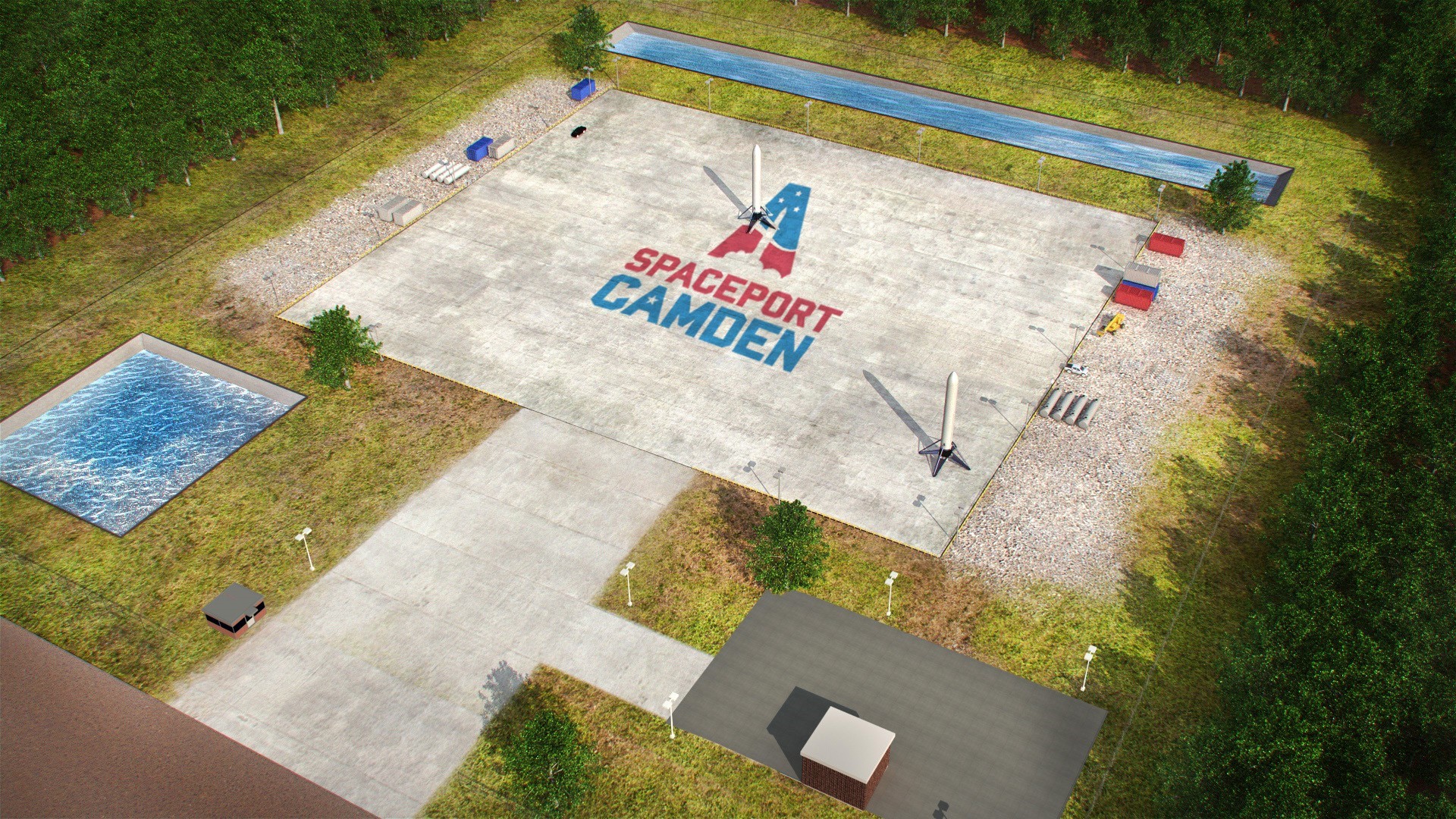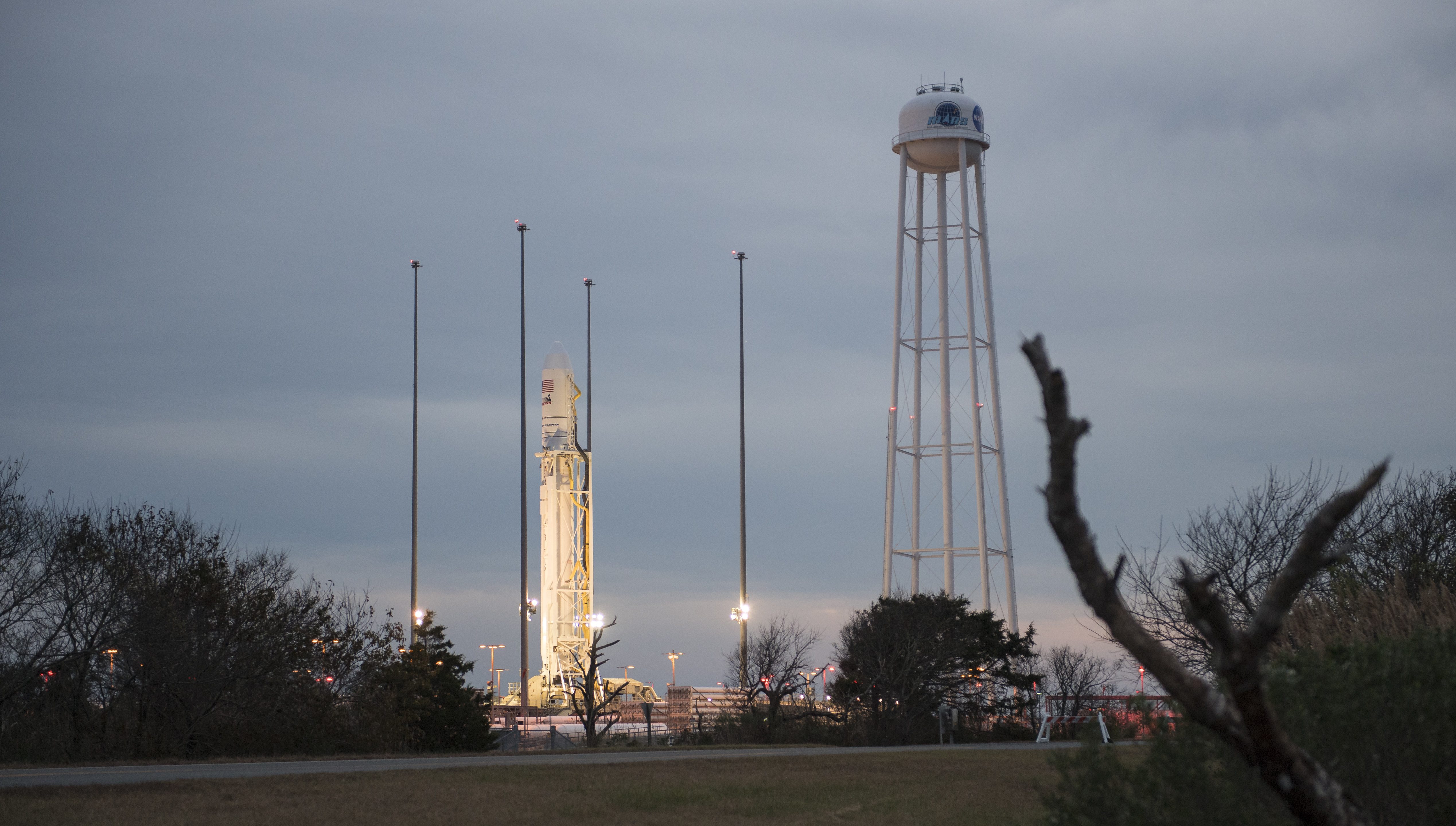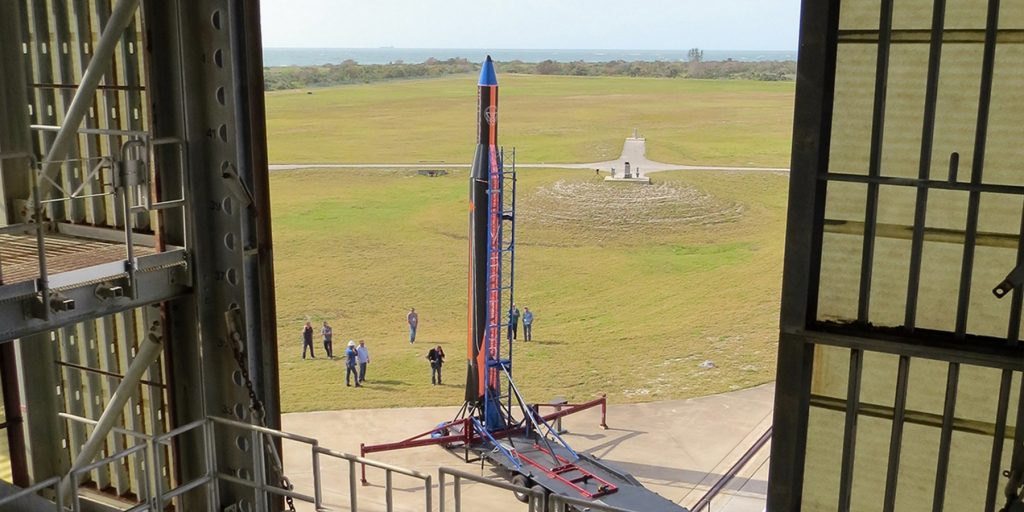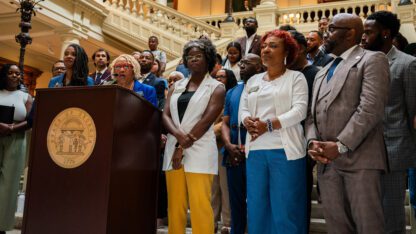Rockets, Risks, Rewards: A Look At The Economics Of Building Spaceport Camden

This rendering from Camden County is part of the county’s plan for a spaceport. Camden has spent about $6.7 million and about seven years working on that plan.
: Camden County Board of Commissioners
This piece is a part of WABE’s deep dive into Camden County’s proposed spaceport project: how it came to be, who could be affected and where it could go from here.
Camden County, on the Georgia coast, is known as the home of Cumberland Island and a naval submarine base, Kings Bay.
But the government wants to be known for something else, too: launching rockets.
Camden has spent about $6.7 million and about seven years on a plan for a spaceport. But the county is taking a big economic development bet on this vision of space jobs in coastal Georgia, despite little proof their proposed business model will work.
They’re awaiting a Federal Aviation Administration decision on the idea, due by December.
“Our vision is a big vision. It’s a bold vision,” Steve Howard, Camden’s county administrator, said to the Georgia House Science and Technology Committee in 2016. “To develop a successful, world-class spaceport through a public, private partnership that establishes Camden County as a commercial space center of the United States.”
The spaceport idea isn’t new. There are already 12 in the U.S. And they’re all chasing a piece of the big-dollar success expected of the commercial space industry.
“The global space economy is over a $300 billion marketplace today and is growing rather rapidly,” said Camden’s chief space consultant Andrew Nelson at that state House committee meeting. “And over the next 10 to 20 years, some market pundits have estimated it’s going to go to about a $2 trillion marketplace.”
UBS forecasts the space industry will grow to nearly $1 trillion by 2040. Morgan Stanley predicts more than $1 trillion by that time. Bank of America Merrill Lynch has said $2.7 trillion by 2045.
Camden County wants to bring some of that growth to Georgia.
The planned commercial vertical launch spaceport would lie along the salt marsh, 15 miles north of the Florida border, on abandoned industrial property the county doesn’t yet own.
But rocket science isn’t easy. What is the county up against?
‘Job Opportunities For Georgia’s Next Generation’
The dream for the spaceport touted today is the same as it has been from the beginning: jobs.
“It is a marathon, not a sprint project,” Howard said to WABE back in 2015.
“I often say, you know, five years from now, what if we got it right and collectively we came together with this vision united? And again, there’s inconvenience with a project like this, but what if we get it right and created Georgia’s first spaceport? Created lots of job opportunities for Georgia’s next generation?”
Howard and the county commission are hoping the spaceport will give high school graduates a reason to come back.
“This gives them hope. This gives them an opportunity to build for the future, and that’s really what’s most exciting about this project,” Howard said.
Right now, the county of about 53,000 people relies on tourism and a military base. About 40% of residents work at Naval Submarine Base Kings Bay in St. Marys, about 10 miles south of the proposed spaceport site.
County Commissioner Gary Blount agrees a spaceport could be something to attract young people like his son.
“He lives in Charlotte,” he said. “Why? Because that’s where the opportunities are.”
Blount thinks Camden has a lot of untapped potential.
With the spaceport, he is mostly interested in ancillary industries, like manufacturing.
“Whether rockets launch or not? I could care less. That’s what attracts everything. That’s what attracts all the attention. What we’re interested in is the industry it has the potential to bring, regardless of what people say.”
Just 77 jobs are projected at the spaceport itself.
William Hairston is an engineering consultant who has lived in Camden on and off for 20 years. He’s a fan of the spaceport idea.
“Anything that would bring jobs to the community would be better than nothing. Something is better than nothing,” he said. “And if you have to pay to invest in infrastructure or to bid on it, I say it’s fine.”
You’ve got to spend money to make money, as he put it. And spend money, the county has definitely done: So far, mostly on consultants and purchase option agreements with the site’s owner.
Camden has spent at least $6.7 million and about seven years on a plan for a spaceport. In addition, the county included a line item for $720,000 in its 2020 budget titled “SP Purchase Option,” but declined to confirm whether or not the “SP” stands for spaceport, and whether or not the money had actually been spent.
But that amount is just a fraction of what other spaceports have ultimately cost. And the county hasn’t paid for the land yet.
Brian Gulliver leads the aerospace and spaceport practice at Kimley-Horn and is a consultant for Camden. He wrote in a research paper that building a spaceport “can be in the $10’s of millions, $100’s of millions or billions.”
New Mexico taxpayers spent $220 million on one. Now, nearly eight years later, 30% of its budget is still state money.

And what’s the possible return on a spaceport investment for Camden? That’s unclear. As space industry consultant Tom Matula put it, the country is “littered” with failed spaceport plans. And given Camden’s chosen spot, over a National Seashore, he said insurance will likely be particularly expensive for hopeful rocket companies.
Even without that complication, it’s difficult enough.
Just a handful of spaceports in the country see regular launches and have generated jobs. And they all seem to have something in common: federal and state subsidies.
Virginia Space on Wallops Island gets nearly $16 million per year from the state, according to its director and CEO Dale Nash. And it is co-located with an existing NASA facility.
That’s a similar setup as Cape Canaveral. Space Florida gets $11.5 million annually from the Florida state budget and shares a facility with NASA’s Kennedy Space Center.
Vandenberg Air Force Base in California has a commercial rocket launch range and had four launches last year. It’s owned by the military.
And then there’s Mojave, also in California. No taxpayer dollars, and it had six launches last year. But it was built on infrastructure from an existing military base. And it’s also a successful airport.
Nash, of Virginia Space, has run two state-owned spaceports, also including the Pacific Spaceport Complex in Kodiak, Alaska.
He said, in his experience with spaceports, it’s been “essential to have strong state support, including financial support, especially in the development phase. A spaceport can be a great economic engine, but it does cost money.”
“Securing an FAA license is only the beginning of creating a spaceport,” he said. “There is a lot of additional investment that needs to be made in facilities and personnel to become successful.”
The Camden spaceport has not secured any federal or state funding.

‘Big Boy Business’
Ray Lugo worked at NASA for nearly 40 years and now directs the University of Central Florida’s Florida Space Institute.
A professional space advocate who is bullish on the growth of the industry, he said safety is getting better and operating costs are going down. However, he cautions hopeful spaceport operators to think through their business plans. He thinks there are already too many spaceports.
“What’s the business case that can be made for [the spaceport] given the fact that the people in Camden County are going to mortgage their future on something which may not, you know, materialize in our lifetime?” he said.
“There are a number of spaceports that have been created over the last 15 years. And if you look at the finances, nobody’s making money.”
Gulliver disagrees that there are too many spaceports and compares the situation to the early airplane industry, when people questioned the need for airports around the country.
“Spaceports are kind of at that point now where it may appear that we don’t need any more. But I expect over the next couple of decades, you’ll see quite a few more pop up, and I think some will be successful,” he said.
Some will not be successful, but in the end, the market will eventually determine the success of the spaceports around the U.S.”
But the cautionary tales do not daunt Commissioner Blount.
Other spaceports’ records, he said, aren’t relevant to Camden because they have a different, new vision.
“We’re not modeling after any particular spaceport because if I brought one up, the first comment someone will say is, ‘Well it’s failing,’ or, ‘they dumped $400 million in and have never made a dime yet.’”
That’s also why, he said, Camden doesn’t have a written business plan.

Camden plans on a public-private partnership, much like an industrial park. The hope is that private companies will come and help with some of the investment.
“We often say, ‘Don’t build it and they will come.’ We say, ‘Let them come and let them build it,’” said County Administrator Howard.
That’s an unprecedented model, but Commissioner Blount is confident it will work.
“There is a definite opportunity, and we have every indication. I’ve been on this since the very beginning, and I am more encouraged than I was to begin with.”
County officials point to a small startup that’s renting an abandoned airport in St. Marys as a sign the space idea is working.
That company, ABL Space, hasn’t yet used the property and hasn’t had a licensed launch.
A different company, Vector, held a rocket prototype test launch near the proposed Camden launch site in 2017. The prototype went 5,000 to 10,000 feet into the air before landing in nearby trees.
But the reality is, attracting a major company to a spaceport costs a lot of money.
That’s according to Brent Hilliard, chair of the Midland Development Corp. in Texas. The town has a spaceport, which until recently, had no tenants.
“This is a big-boy business. It’s a big-girl business,” he said. “It’s big money, especially with a new spaceport. You’re competing with a lot of existing infrastructure that is very comfortable for people to use.”
Big money.
Like the $20 million Florida gave in incentives to one satellite manufacturing company. Elon Musk’s SpaceX received about $15 million from Texas to build its own private spaceport. Oklahoma gave a space travel company $18 million in state incentives before that company moved and ultimately went bankrupt.
And the city of Midland gave XCOR Aerospace $10 million, back in 2012.
Andrew Nelson used to be an executive there and is now Camden’s chief space consultant.
XCOR planned to take passengers up to space in a rocket-powered spaceplane and sold advance tickets for about $100,000.
Then the company went bankrupt. Many of those ticket purchasers haven’t gotten their money back. Midland was left out of luck, too.
Nelson declined to comment for this story.
Jerry Brandon, a former mayor of St. Marys and local hotel owner, said he’s skeptical a spaceport would ever make enough money to pay for itself, just as he was skeptical of a speculative industrial park project when he was in office.
“If it’s worthwhile, developers are going to do it anyway. I don’t think taxpayer dollars should be spent that way,” he said.
Lugo, with the Florida Space Institute, actually testified at a public comment meeting in Camden, trying to present this cautionary message about the financial risk.
“I felt bad because they did it at a high school,” he recalled.
“And there were a few teachers that were saying, you know, ‘This is something that gives our kids something to dream about.’ And I totally get that. But I just think this is not a realistic dream.”
Read part two of this special report here.












